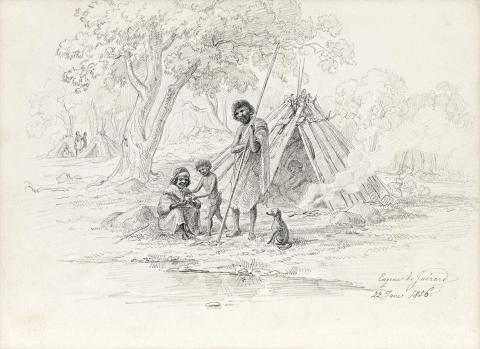ABORIGINAL FAMILY GROUP, 1856
EUGENE VON GUÉRARD
pencil on cream wove paper
17.5 x 24.0 cm
signed and dated lower right: Eugene de Guerard / 22 June 1856
bears inscription verso: This is for Margaret to put in her Album / The Artists name is affixed.
Good family, Victoria from 1856
Margaret Good, Ireland, a gift from one of her sisters, Kate or Mary
Thence by descent
Josephine Kenrick, Melbourne
Amanda Addams Auctions, Melbourne, 6 August 2012, lot 238 (as ‘Aboriginal Camp’)
Private collection, Melbourne
This sensitively drawn portrait of an Indigenous family group and their temporary bark gunya (shelter) dates from a journey Eugene von Guérard undertook in 1856 to Victoria’s Western District. Originally attracted by the lure of finding gold, the Austrian-born von Guérard was unsuccessful as a digger so turned to painting his adopted country instead. Trained at the rigorous Düsseldorf Academy in Germany, his meticulously detailed paintings done in the Romantic tradition of the sublime found favour with Australian audiences, particularly landowners keen to commission grand views of their estates. The trek through the Western District was connected to one such project with this drawing being executed along the way.
Dr Ruth Pullin, the noted von Guérard specialist, has kindly provided detailed notes for this work based on the artist’s sketchbook: ‘Von Guérard was at James Dawson’s property ‘Kangatong’ (near Tower Hill) on 22 May 1856 and at that time he did the sketch for the painting Cutting the cattle, Kangatong, 1856. He then headed north for a three-week sketching expedition along the eastern side of the Grampians-Gariwerd Range, travelling from Dunkeld in the south to Mt Zero in the north, and back again. On 16 June he was on the Wannon River near Mt Sturgeon, noting that he was then on the return journey to ‘Kangatong’. There are no drawings in the sketchbook for the week between 16 and 24 June, and it is during this time that the drawing in question was produced; the next drawing in his sketchbook is dated 24 June 1856 and von Guérard was then at Mt Eccles. The artist’s visit to Mt Eccles was made in the company of James Dawson and Charles Hamilton McKnight. Von Guérard and Dawson stayed at McKnight’s property ‘Dunmore’ on 23, 24 and 25 June’. Pullin also notes that the use of ‘de’ instead of ‘von’ in his signature here is due his family having French origins and this variation appears on a number of his drawings and lithographs.
Aboriginal Family Group, 1856 shows surviving individuals from the Gunditjmara people who were the traditional owners of the area now encompassing Warrnambool, Portland, Hamilton and Mt Eccles.1 The Gunditjmara were amongst the first in Victoria to be subjected to frontier violence with a massacre of up to 200 of its people by whalers at Convincing Ground, east of Portland, in 1830, five years before Melbourne’s foundation. This event triggered what is now known as the Eumeralla wars which lasted more than 20 years and decimated their population. Significantly, von Guerard’s host and travelling companion James Dawson was an early champion of the local Aboriginal people, researching and documenting their languages and customs over many years.2 This drawing was originally owned by the Good family, members of which emigrated from Ireland in 1841, settling on a property called ‘Injemira’ just outside Warrnambool. Pullin notes that von Guérard rarely gifted his drawings so it is unclear how this example came to be in the possession of the Goods. What is known is that at some stage either Kate or Mary Good sent it to their sister Margaret (who had remained in Ireland) ‘for her album,’ a scrapbook journal containing her own competent drawings of views, birds, butterflies and flowers; and in which the von Guérard was kept as a loose drawing. Given these circumstances, the featured Indigenous family does not appear in any of the artist’s subsequent paintings though similar portraits often appear in his sketchbooks, an irreplaceable record which reveals von Guérard as a sympathetic observer of the varied indigenous peoples he met on his extensive travels throughout eastern Australia.
The author thanks Dr Ruth Pullin for her assistance in identifying this work.
1. Also known by its Gunditjmara name of Budj Bim.
2. Dawson and his daughter Isabella published Australian Aborigines: The Languages and Customs of Several Tribes of Aborigines in the Western District of Victoria, Australia in 1881.
ANDREW GAYNOR
